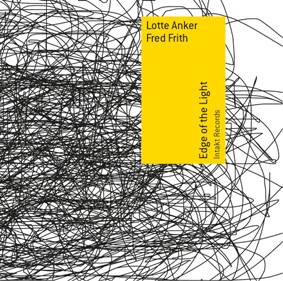Am 11.7.2010 traf sich FRED FRITH in Kopenhagen mit LOTTE ANKER und
deren Saxophonen für Edge Of The Light (Intakt CD 237). Die Ko-Leaderin
des Copenhagen Art Ensemble und Triopartnerin von Sylvie Courvoisier &
Ikue Mori oder Craig Taborn & Gerald Cleaver fand sich im Miteinander mit
Frith in Dreamscapes versetzt. Mit Scape meint sie das Plastische von Friths
Klangformen, mit Dream den quasi unaufhaltsamen Fortgang von Ereignissen,
derer die Protagonisten nicht mehr ganz Herr sind. Trotz des Ankers in
der Erfahrung und der Kontrollmechanismen des Bewusstseins stellt sich im
Stream of Consciousness etwas Halluzinatorisches ein und die Intuition
agiert wie ein Waschbär in der Nacht. Frith spaltet sich immer wieder in zwei
Kanalspuren oder zermorpht den Gitarrensound, bis das Hinderste zuvorderst
erklingt. Aber er kann sich so auch dem Saxophonklang nahezu Ton in
Ton anschmiegen oder ominös krabbeln und knistern. Ankers stöberndes
Musing, ihr angerauter und meist etwas schiefer, leicht brüchiger oder luftlöchriger
Zungenschlag, animiert Frith jedenfalls zu deutlich anderen Gesten
und Klängen als Barry Guy das tat. Wobei er sich bei 'The Mountain is as
Quiet as the Eternal Past' wie auf Zehen- oder in seinem Fall: Fingerspitzen
bewegt oder die Saiten mit einem Stift anschlägt. Frith triggert seine Sounds
ja neben den Fingern immer wieder gern auch mit Pinseln oder Metallstücken,
um zu gezupfen Tönen getupfte, gehupfte, gezogene und gebogene zu
mischen ('Thief Breaks into an Empty House'). Das kann dann fast mal wie
eine Drehorgel oder ein Innenklavier klingen. 'Hallucinating Angels' besticht
zuletzt mit sopranistischer Zartheit und seraphischem Flirren und Dröhnen.
Bis plötzlich ein ganz anderer Zug kreuzt, eine Sklavenkarawane und ein
galoppierender Reiter, deren Bestimmungsort sicher nicht die elysischen
Gefilde sind. Die Gitarre findet das zum Schreien. Aber es ist ja nur der Albtraum
eines Engels.
Rigobert Dittmann, Bad Alchemy, Würzburg, 84-2014
Den engelske gitaristen Fred Frith er blant de mest grensesprengende innen faget. Her kommer to utmerkede eksempler på det.
Fred Frith er en etterhvert 65 år ung innovatør som helt siden 70-tallet, i grensesprengende rockegrupper som Henry Cow og Art Bears, har vært en kompromissløs musikant. Frith la ganske raskt fotballøya bak seg og satte kursen for USA og nye utfordringer og, i tillegg til å bidra i en rekke musikalske konstellasjoner, så jobber han også som professor ved Mills College i Oakland, California.
Denne doble dosen med Frith åpner med et av mange møter han har hatt med dronninga av dansk frijazz, saksofonisten Lotte Anker. De to hadde spilt sammen under Copenhagen Jazz Festival sommeren 2010 og benytta samtidig anledninga til å sette av noen timer i studio.
De gir oss åtte musikalske landskapsmalerier som uten unntak er unnfanga der og da - slik de nesten alltid er når Anker og Frith er involvert. Her skapes det spenninger, teksturer og samtaler som ingen andre på kloden kunne ha skapt. Lydarsenalet de to - spesielt Frith - har tilgang til er intet mindre enn voldsomt og unikt og de to forteller oss at de er utstyrt med en kjemi og empati som har ført til enda mer styggvakker musikk.
Bassisten Barry Guy og Frith kommer fra den samme øya og jobba sammen såvidt det var for rundt 40 år siden - uten at Guy kan huske det! For Frith blei det en inspirerende opplevelse og noe han hadde ønska å gjenta. I 2007 dukka muligheten opp - i Guys nye hjemland Sveits - og her foreligger resultatet. Lydlandskapene blir helt annerledes enn i møtet mellom Anker og Frith, men det musikkfilosofiske utgangspunktet er mye det samme: det som skjer det skjer.
Både bassen og gitaren blir utnytta på høyst personlige vis og samtalene blir deretter. Dette er heller ikke musikk som er låtbasert i tradisjonell forstand - her er det store lerett som blir spent opp og der mange farger blir benytta.
Barry Guy og Fred Frith venta lenge med gjenforeninga. Det var kanskje grunnen til at de hadde ekstra mye på hjertet.
Tor Hammero, Tor de Jazz, 09.01.2015

John Sharp, The New York City Jazz Record, Feb 2015
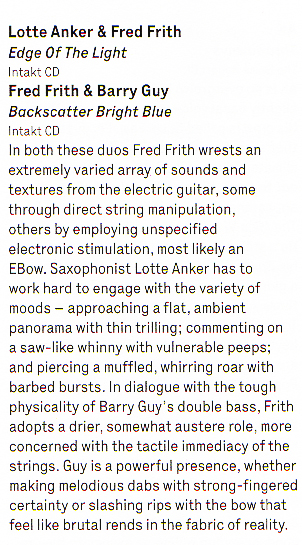
Daniel Spicer, The Wire, London, February 2015
Enjoyment in each other's company
The Copenhagen saxophonist Lotte Anker and the versatile composer and contemporary guitar pioneer Fred Frith enjoy each other's company, and it sounds like it. Frith loves the duo setting for its urge toward "meeting, conversing, challenging each other, changing your mind, not changing your mind, running together for the fun of it", and Anker describes this session as having been a "timeless bubble … that was small, but in a way also vast". Anker's rich saxophone palette takes in skimming falsetto sounds like Evan Parker's, but she also has a soulfully desolate quaver that recalls Albert Ayler, and a sense of narrative drama that keeps her in compelling motion between ghostly impressionistic effects and brusquely percussive exclamations. Frith confronts Anker with flinty and splintered Derek Bailey-esque interrogations, but also partners her with astonishing resourcefulness – a kind of onrushing swing on Anchor Point, and galloping hooves on Run Don't Hide, allied with hand-drumming effects, glowing electronic textures, bowed-metal noises, and the sounds of somebody shovelling gravel or searching among heavy objects. He's been an extraordinary sound source for decades, and he isn't letting up.
John Fordham, The Guardian, GB, February 27, 2015

Stéphan Ollivier, Jazzmagazine/Jazzman, France, Mars 2015
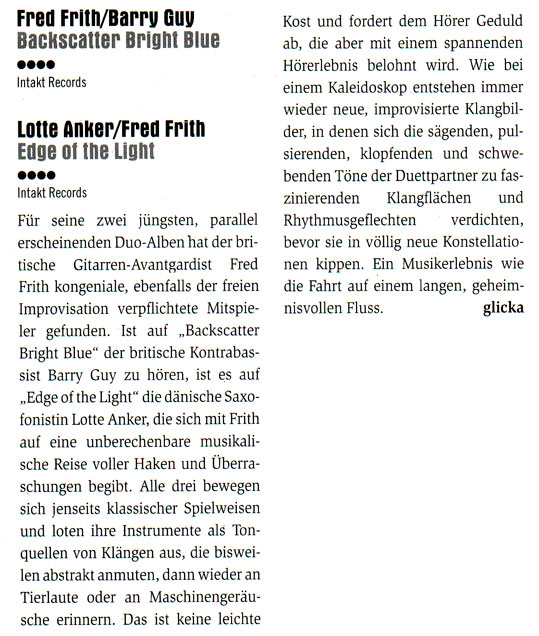
Karl Gedlicka, Concerto, Februar/März 2015, Österreich
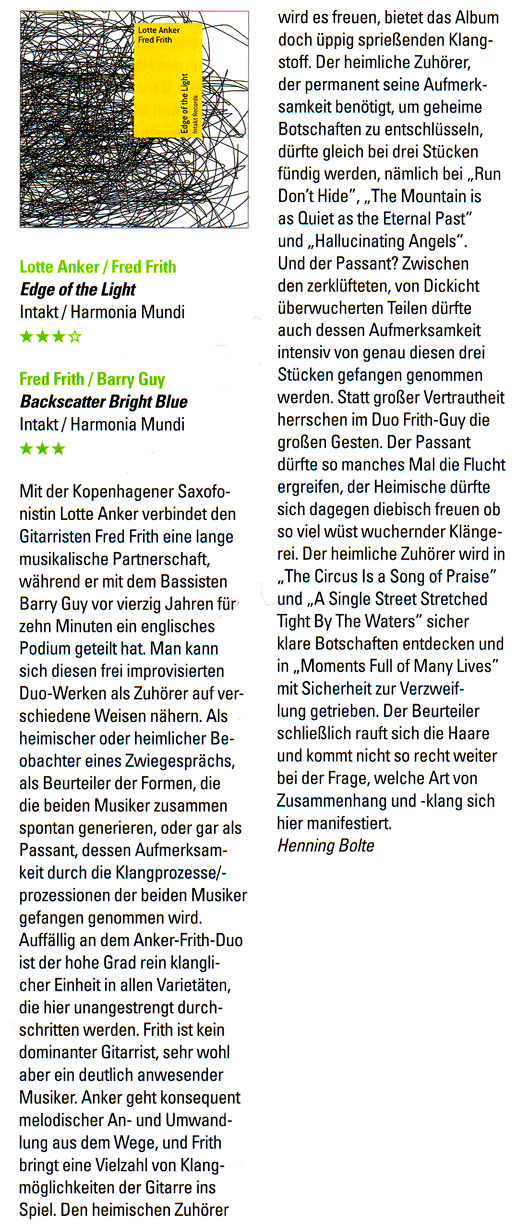
Henning Bolte, Jazzthetik, März/April 2015, Deutschland

Daniel Spicer, Jazzwise, London, April 2015
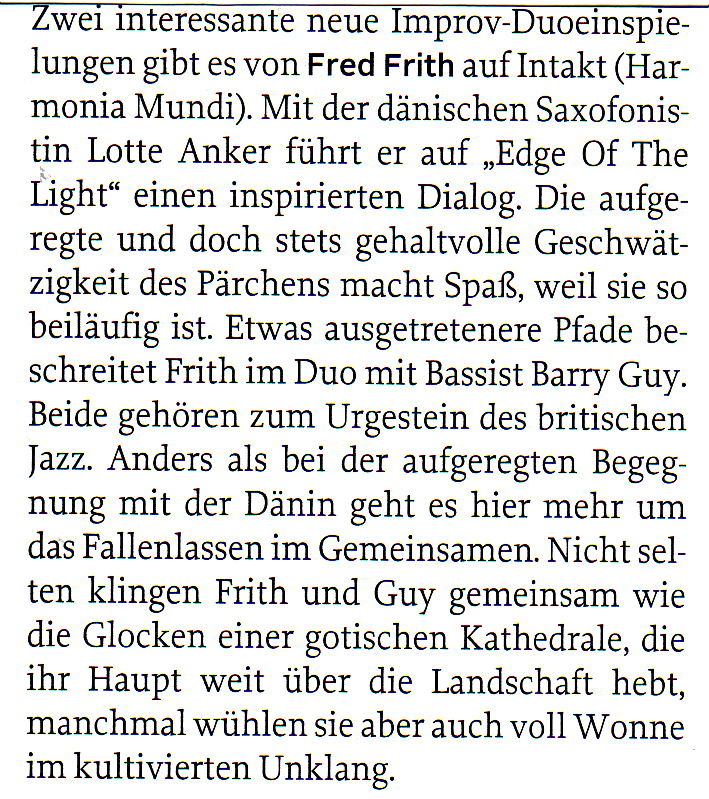
Wolf Kampmann, Jazzthing, April 2015
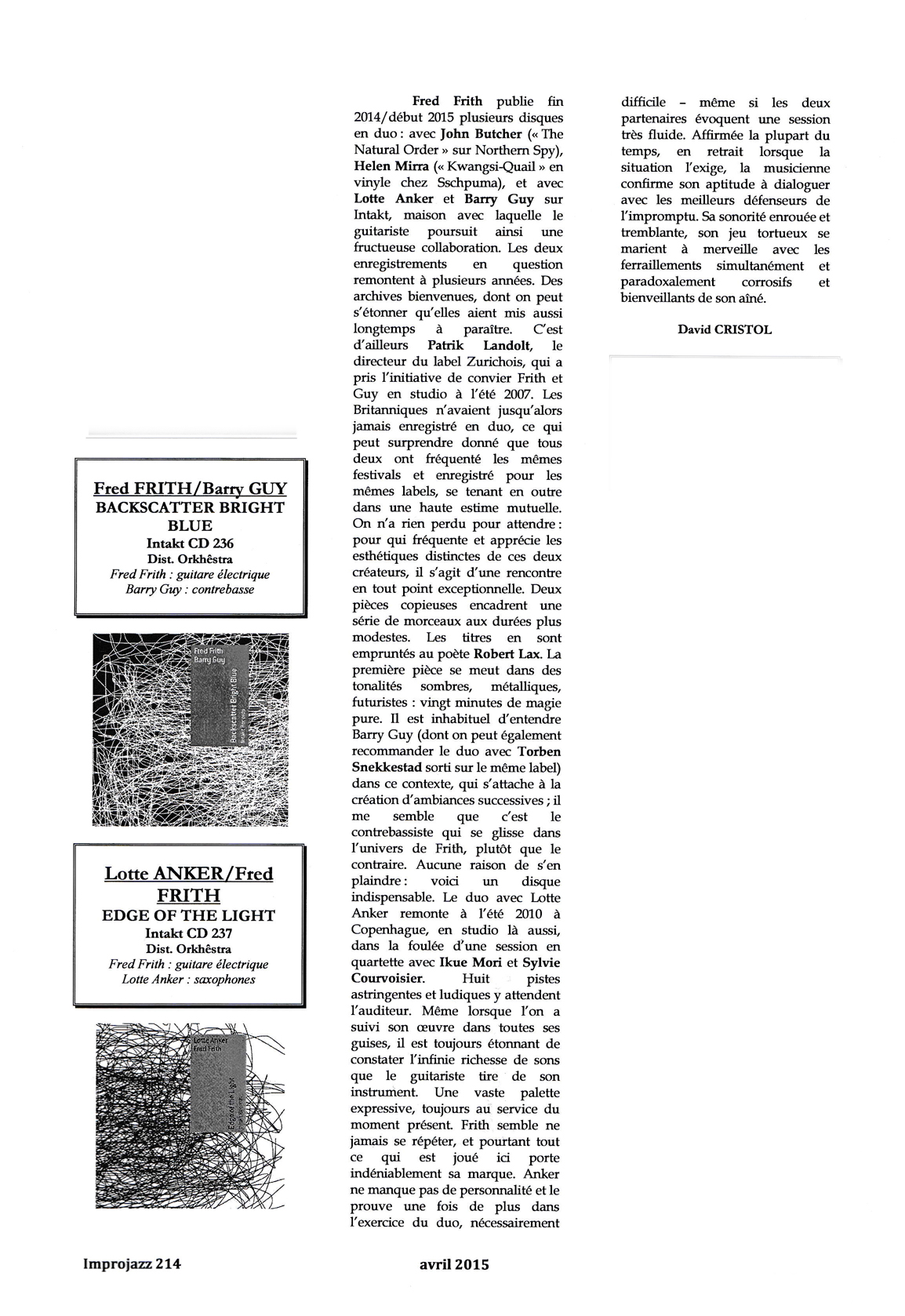
David Cristol, Improjazz France, Avril 2015
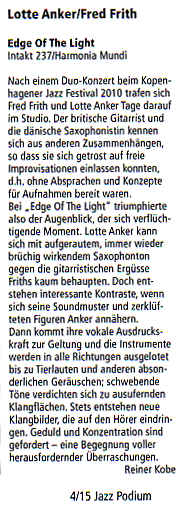
Reiner Kobe, Jazzpodium, April 2015
Most often, when I can't figure out the appropriate genre designation for an album, it ends up going into the Jazz section. (I'm not proud of that, but there it is.) In this case, though, and despite the fact that the unifying element of these two albums of improvised music is the presence of electric guitarist Fred Frith, it seems as if Classical is the right home for them. On Edge of the Light, Frith is working with saxophonist Lotte Anker, whose piercing and direct playing contrasts nicely with the wild textural variations of Frith's extended techniques. On Backscatter Bright Blue he is teamed up with contrabassist Barry Guy, and here (unsurprisingly) the sound is very different, with both musicians creating a broad sonic palette of tones, scrapes, squeals, snaps, and clatters. Libraries with a collecting interest in improvisation and the avant-garde should be very quick to snap these up — along with just about any other album to which Fred Frith contributes in any way.
Rick Anderson, CD HotList New Releases for Libraries, USA, March 2015

Ken Vos, Jazzism, Maart 2015, Nederlande
Fred Frith is in de loop van de afgelopen decennia wellicht uitgegroeid tot de meest experimentele gitarist binnen de jazz/rock. Een gitarist die met behulp van een overvloed aan technieken en hulpmiddelen een volstrekt uniek klankuniversum creeërt, waarbij in zijn spel de gitaar als zodanig vaak niet eens meer te herkennen valt. Het blijkt ook weer uit twee recent bij het Zwitserse kwaliteitslabel Intakt Records uitgekomen duo-cd's. Eén met saxofoniste Lotte Anker en één met bassist Barry Guy. In beide gevallen zijn het opnamen van reeds enige jaren terug, maar het mag een wijs besluit heten van Intakt om deze opnamen alsnog uit te brengen.
Frith en Anker spelen een bevlogen en spannende set. Beide musici hebben het explorerende, verkennende hoog in het vaandel staan. Ze tasten elkaar af, trekken samen op, maar gaan ook regelmatig ieder hun eigen weg. Beide grossieren in onverwachte en bizarre klanken, maar vooral Frith staat hierin zijn mannetje. Tegelijkertijd weten beiden echter ook weg met het serene, bijna transcendente, met als hoogtepunt - hoe kan het ook anders gezien de titel - 'Hallucinating Angels', het slotstuk van de cd. Opvallend is ook hoe dicht de beide musici elkaar soms benaderen qua klankkleur en toonvorming. In 'Reasonably Available Control Measures' klinkt de sax van Anker op enig moment bijna als een gitaar. En ook het vraag-en-antwoordspel op 'Thief Breaks Into An Empty House' valt in deze categorie.
De set van Frith en Guy is zo mogelijk nog experimenteler. Het is ook minder een duet-cd. Guy zegt zelf over deze set: "We created a music which is syllogistic in the sense that the end product is drawn from two very different musical lives, each refecting our own history." Het eerste stuk, ruim twintig minuten lang, is dan ook voor een groot deel een complex klankuniversum. Onwezenlijk, soms onheilspellend, precies wat je verwacht bij de titel: 'Where The Cities Gleam In Darkness'. Juist, de geluiden van de nacht. Bijzonder ook hoe zich, net over de helft, ineens een spannend ritme ontvouwt, gebruikt door Frith om eens treffend op te soleren. Er is ineens leven in de duisternis. Het ander lange nummer, 'Moments Full Of Many Lives', is eveneens een hoogtepunt. Het klinkt alsof er iemand stukjes muziek van verschillende tapes aan elkaar heeft zitten plakken. Fragmenten schieten voorbij, waarbij de muzikale structuur en kleur snel wisselen. In de tweede helft doet een hallucinerend ritme zijn intrede. Als een steeds heftiger wordende draaikolk biedt het ondersteuning aan de extatische gitaarriffs van Frith. Een memorabele climax.
Ben Taffijn, Jazz en meer, 15.4.15
Guitarist/composer Fred Frith loves to play in duos, testing the malleability of his own instrumental language as well as its adaptability to varied pairings and styles. It's good to hear more of him in this format, both on the recent release with John Butcher and on these two fine documents from Intakt.
Saxophonist Anker plays in an assertive, tough-minded style that's well suited to improvising with Frith. She digs in and wails as he cranks out chords and taps furiously on "Anchor Point," and her assured rhythmic sensibility works quite well here and throughout the well-paced disc. While her sound doesn't undergo as many outward transformations as Frith's does, she's smart, adaptable, and plays with good humor. Hear her range on "Run Don't Hide": its sweet drone wash cedes to one of Frith's wonderfully obsessive tapping/arpeggiating cycles, to which Anker responds with first echolalia and then sour alto birdcalls. Frith plays with loops, layers of nasty distortion, metallic scrambles, and buzzing hives of noise, and amidst it all, Anker sounds like some kind of shaman attempting to communicate with the cosmic realities of his guitar (except for those times when she sounds like she's trying to tame its beastliness, as on "Reasonably Available Control Measures"). But there's considerable sonic and textural range here, from tart lyricism to relative calm to gentle lapping percussion, and in any case things are never merely noisy. Amidst its flinty, choked-off plucking and darting tenor, "The Mountain is as Quiet as the Eternal Past" manages to get quite folkish in places. There is drifting tonality, wafting electricity, singing feedback and circular breathing on tunes like "The Same Dirt" and "Hallucinating Angels," great whorls of sound take shape around your head. And perhaps best of all is the unpredictable "Thief Breaks Into an Empty House," with flute tones and electronics whizzing about, furtive and slashing at once.
Frith's duo with Guy is another dazzlingly good match. It's always a treat to hear Guy bring his sonic universe coursing through a wormhole into someone else's. His array of rubbery notes, eldritch arco effects, and raw percussive sound resonates nicely with Frith. They're in an especially scratchy mood on the 20-minute opener, "Where the Cities Gleam in Darkness." It ranges from this deep engagement with the grain of strings into a fantasy for spring-loaded effects and rayguns, and from there into a lovely contrast between Guy's deep melancholy fugue and Frith's loop-generated canopies of stars. Even more than on Edge of the Light, this disc really takes shape amid such moments of resonant juxtaposition. Between bass double-stops and rubber depth charges, Frith applies razorblades to blown glass. A noisy gamelan and subway train erupt in "The Circus is a Song of Praise." There are lathered-up grooves laced with spun-glass plectrism. Moody, almost textural miniatures like "Big Flowers" and "Breaking and Entering" frame long spirals into melancholy song ("A Single Street Stretched Tight by the Waters," which even evokes Loren Connors), bustling string manipulation and radio voices ("Climbing the Ladder"), or guitar deconstruction channeling Early Music ("Dependence over the Abyss"). Often, as on the long closer "Moments Full of Many Lives," you get the feeling of being shuttled forward and off-balance in some postmodern Gagaku machine. The whole disc feels like a dizzying rush of momentum, tailspins at its conclusion into a lovely drone section that spools out at length, with myriad changing details and swirling textures. Glorious.
Jason Bivins, Point of Departure, USA, PoD50, 2015
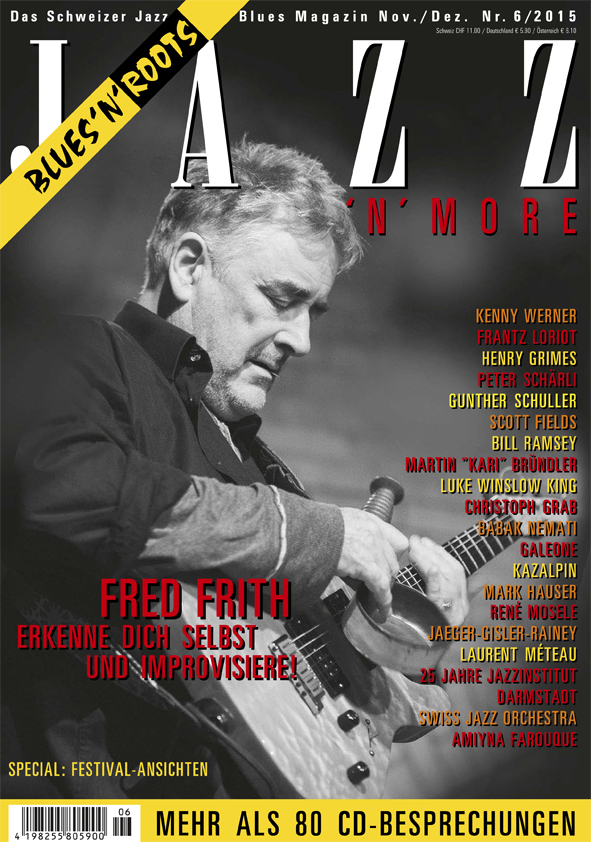
Portrait Fred Frith. Rudi Ankli, Jazz'n'more, November 2015
Danish saxophonist Lotte Anker has been involved in a diverse cross section of musicians since she first began recording in 1985, from the Copenhagen Art Ensemble to sessions with the likes of pianist Marilyn Crispell and drummer Gerald Cleaver. One of the most fruitful of recent collaborations has been with British guitarist Fred Frith and these two discs show off Janus-faced sides of this combination.
Commissioned by Huddersfield Contemporary Music Festival and Copenhagen's Wundergrund Festival, What River is This is an extended composition obliquely dealing with hypnagogia, the transitional state from wakefulness to sleep. Besides Anker and Frith, the ensemble especially formed exclusively for the performance includes clarinetist Anna Klett, violist Garth Knox, bassist Jesper Egelund, percussionist Chris Cutler, Ikue Mori on electronics and Phil Minton, singing words as well as producing expected verbal noises. Lighter in personnel, with only Anker playing soprano, alto and tenor saxophones plus Frith on guitar, Edge of the Light is also … well, edgier.
Over the course of eight tracks on the second CD the saxophonist and guitarist demonstrate their close affiliation with a variety of textural explorations with Anker's horns brushing up against appropriate sonic path-finding from Frith electric guitar lines and vice versa. Like computer programmers who keep track of the underlying operating system even as they try out new processes, the two never deny the expected string-reed cohesion however. Among the tongue splattering and narrowed sputters on the saxophonist's part and the chordal crunches and string and amp recoil from the guitarist, you can detect a thematic circle closing from the introductory "Anchor Point" to the concluding "Hallucinating Angels".
Metaphorically fastening on those technological concepts for which the programmers would be searching, the duets here are exploratory rather than details oriented. On "Thief Breaks into An Empty House" for instance, Frith's interface is such that Anker's tenor saxophone output that runs from growling snorts to altissimo puffs could be trading licks with an out-of-tune calliope. Rasping flanges and grating buzzes from Frith on "Reasonably Available Control Measure" catch up with Anker's whines and wiggles to the extent that the desolation of cosmic travel is sonically posed before squeezes and peeps resolve this into cooperation. Perhaps another space ship has arrived. Taking into account the construction of their respective instruments, the two can also mimic each others' output. As they do on "Run Don't Hide". As swift as a theatrical scene change in a one-person performance, clanking guitar runs and squealing alto saxophone bites assimilate so many extensions of the root tones that it's almost impossible to distinguish reed from string. Luckily a downshifted coda of string strumming and graceful breaths eventually reveal the personnel.
As different as a concert hall is to a nightclub, the concept and presentation of What River is This is about as far as can be from the almost casual duets that make up Edge of the Light. For a start, with the eight-piece ensemble including more typically orchestral instruments such as viola and clarinets, the tendency is to harmonize and color the proceedings rather than emphasize solo work. Additionally, another factor which makes Anker's 10-part suite programmatic is Minton, who usually can't find a timbre he can't mangle from within a mouth cavity, as well as he sing-speaking words and phrases that illuminate the underlying hypnagogic state of consciousness. With thematic material stated with dreamy tonality on "The Sleeping &The Awake/Apx 1" and repeated three subsequent times, the shape of the composition is set.
Key to the presentation is that much of the program is designed for group realization. Like the tones of a pipe organ harmonized in unison to make a throbbing whole, the result is infrequently pierced by singular strokes. These, which range from the electronic squiggling or plunger tones, or reed squeals are only momentary distractions and never upset the suite's inevitable forward movement.
A compelling swing meter from the bassist and drummer does arrive on "The Sleeping & The Awake/Apx 2". But even as that piece then slips into a hubbub of disquieting saxophone flutter tonguing, double-stopped string pop and madhouse-like voice glossolalia from Minton on "Running - Getting Nowhere" and much later on "Nightmares Exist", the exposition is expanded and elaborated but never ruptured. Finally with wispy instrumental overtones backing Minton's reiteration, the piece settles into a satisfying if somewhat conventional finale.
Both CDs prove Anker's creative skill in different milieu. Depending on preferences some may want her improvisatory skills upfront alongside Frith, or her compositional talents on display as part of a well-modulated ensemble.
Ken Waxman, Jazzword, January 2016
Les disques qui vous ont (peut-être) échappé durant l'année passée
de Jean Buzelin , Culturjazz, France, 31 janvier 2016
Nous continuons à écrémer les étagères où se sont réfugiés, durant l'année 2015, nombre de disques fort intéressants, lesquels ont dû patienter avant de faire l'objet de ce simple article d'information qui, je le rappelle, n'est en aucun cas une revue critique.
Nous commencerons par l'un des plus beaux labels indépendants européens, Intakt, maison suisse fondée il y a 30 ans par Patrik Landolt et qui, pour l'occasion, a édité un catalogue comprenant la reproduction en couleurs des 253 CD édités durant cette période. Lorsque l'on feuillette ce catalogue, on est frappé par la cohérence de la collection, les choix effectués, les risques assumés, et le suivi de nombreux artistes qui, en toute confiance du producteur, apparaissent régulièrement, certains depuis les tout débuts : Irène Schweitzer, Barry Guy, Günter Sommer, Pierre Favre, Elliott Sharp, Sylvie Courvoisier, Lucas Niggli, Alexander von Schlippenbach… puis Aki Takase, Fred Frith, Ingrid Laubrock, Ulrich Gumpert… les Américains Anthony Braxton, le Trio 3, Tom Rainey, Marylin Crispell… et tous ceux dont vous avez pris connaissance si vous avez eu la gentillesse de suivre mes chroniques.
Le guitariste Fred Frith apparaît dans deux duos improvisés très différents, l'un avec Barry Guy, « Backscatter Bright Blue » (Intakt 236), l'autre avec la Danoise Lotte Anker, qui explore toutes les possibilités de ses saxophones, « Edge of the Light » (Intakt 237). Il rejoint ensuite la pianiste Katharina Weber et le batteur Fredy Studer dans une séance d'improvisation libre, tendue, tantôt nerveuse, parfois bruitiste (dans le sens "musique contemporaine"), et, sommes toutes, peu lyrique, malgré l'intense "swing libre" du grand Fredy Studer : « It Rolls » (Intakt 248).
La pianiste Aki Takase dialogue, quant à elle, avec le violoniste Ayumi Paul, qui travaille habituellement dans le champ classique et contemporain. L'atmosphère de leur disque se situe dans un esprit très "milieu du XXe siècle". Ainsi sont évoqués Satie ou Stravinsky, mais Bach et Mozart ne sont pas oubliés non plus. Mais qu'on ne s'y méprenne pas, il s'agit de création musicale, et de la plus belle manière qui soit : « Hotel Zauberberg » (Intakt 244)
 (OUI, on aime !). (OUI, on aime !).
Le Schlippenbach Trio est un groupe de briscards de la free music, le pianiste et ses compères Evan Parker (ténor sax) et Paul Lovens (batterie) jouent ensemble depuis 45 ans ! Mais les uns comme les autres ont évolué et pris du recul ; ce n'est plus le free dévastateur des années 70, et leurs quinze pièces directement improvisées sont à la fois très différentes et parfaitement cohérentes. On appréciera particulièrement le jeu lyrique et "coltranien" de Parker. Trois géants : « Features » (Intakt 250).
Ulrich Gumpert, lui aussi un vétéran, fut l'un des grands pionniers de la nouvelle musique est-allemande à l'époque où il n'était pas facile de franchir le mur ! Il est entouré ici de trois musiciens plus jeunes avec qui il joue régulièrement, notamment le saxophoniste Jürg Wickihalder, dont nous avons déjà parlé, toujours proche de Steve Lacy. Un excellent et réjouissant disque de jazz : « A New One » (Intakt 257).
Le Omri Ziegele Billiger Bauer Nonet comprenant deux saxophones (Omri Ziegele et Jürg Wickihalder), la pianiste Gabriela Friedl, un trombone, une guitare, une basse électrique, une contrebasse et deux batteries qui accompagnent les vocaux de Isa Wiss, me laisse par contre un peu sur ma faim. Malgré la qualité du travail, ces « 15 Herslider » mêlent texte et musique de façon un peu alambiquée (Intakt 247). Je n'accroche pas non plus à l'univers de la chanteuse Sarah Buechi, et à sa voix éthérée, certes parfois persuasive, mais aux tonalités très égales dans un genre que j'appellerai "jazz folk libre et souple", même si je dois reconnaître l'intérêt des textes et la qualité du travail musical : « Shadow Garden » (Intakt 259).
Autre saxophoniste suisse déjà connu dans ces colonnes, Christoph Irniger, accompagné par Raffaele Bossard (basse) et Ziv Ravitz (drums), joue une musique très fine qui manque peut-être d'accents et de contrastes mais n'exclut pas une certaine densité. Cela vient en partie du jeu maîtrisé, plutôt linéaire et sans aspérités du saxophoniste qui possède un grand sens de la mélodie. « Octopus » (Intakt 253) est un toutefois un beau disque.
Et l'on retrouve la pianiste Irène Schweizer, artiste N°1 du catalogue – sur les huit premiers disques, sept lui sont consacrés, dont le 001 – qui affronte en duo le grand percussionniste Han Bennink, genre de confrontations auxquels ils se sont rendus maîtres. Changements de rythmes, incessantes relances, drumming foisonnant… parcourent ces dix improvisations et quatre reprises. Quelle fraîcheur ! Quand on pense à tous ces "jeunes" musiciens et chanteurs qui jouent avec application la musique de leurs grands-pères. Rien ne vaut les grands-parents originaux, « Welcome Back » en est une preuve irréfutable (Intakt 254)
 (OUI,on aime !). (OUI,on aime !).
Aly Keïta (balafon, kalimba) est Ivoirien, Lucas Niggli (percussions) et Jan Galega Brönnimann (clarinettes et saxo soprano) sont tous deux nés au Cameroun et amis d'enfance. La réunion des trois aboutit à un vrai travail d'écoute, de compréhension et d'improvisation – rien à voir avec une pseudo world music superficielle et opportuniste. Une musique entraînante, agréable – pourquoi pas ? – et vraiment originale : « Kalo-Yele » (Intakt 261).
Déjà auteur de deux disques en trio (avec Niggli et Michel Godard), l'accordéoniste italien Luciano Biondini se présente cette fois en solo et réinterprète – il compose également – une série de belles mélodies populaires italiennes, en jouant sur la tradition folklorique méditerranéenne et l'improvisation jazz ; toute la nostalgie poétique que véhicule cet instrument quand il est si bien joué se retrouve dans « Senza fine » (Intakt 255) (OUI, on aime !)
 (OUI, on aime !) (OUI, on aime !)
Un volet important de la production Intakt est réservé aux musiciens américains, de générations et de communautés différentes, parmi les plus intéressants au niveau de l'engagement, de la recherche musicale, de l'honnêteté artistique et de l'idée qu'ils se font de leur travail.
Familier du label avec le Trio 3, le saxophoniste Oliver Lake rencontre cette fois le contrebassiste William Parker, soit, d'un mot, le tranchant de l'alto face à la basse profonde, et d'un autre, la création qui s'appuie sur la grande tradition afro-américaine. Ils sollicitent ainsi Marvin Gaye et poursuivent avec une série de duos d'autant plus intenses – l'un porte le nom de notre regretté ami Jacques Bisceglia – qu'ils sont encore sous le choc de la disparition, survenue cinq jours avant la séance, de leur ami le trompettiste Roy Campbell. D'où le titre de leur album : « To Roy » (Intakt 243). C'est également un plaisir de rencontrer, pour la première fois sur Intakt, le grand saxophoniste ténor Chico Freeman pour un autre duo avec un contrebassiste, Heiri Känzig, musicien suisse né à New York – il joue dans le trio de Harry Sokal – dans une expression plus "coulante", moins free si l'on veut. On savoure ce double plaisir, en retrouvant le beau et solide son du ténor lyrique et de grande tradition, en particulier dans les ballades où il excelle : « The Arrival » (Intakt 251).
Poursuivons par une série de trios avec, tout d'abord, celui d'Aruan Ortiz, musicien d'origine cubaine résidant à Brooklyn. Ce pianiste de 42 ans a déjà une carrière riche et variée, à Cuba, en Espagne et aux États-Unis, tant dans la tradition afro-haïtienne que dans les formes ouvertes des musiques contemporaines. On remarquera notamment le travail harmonique et rythmique, avec une dynamique et une pulsation propres et des rythmes complexes avec lesquels le batteur Gerald Cleaver fait toujours merveille. Le bassiste Eric Revis étant également excellent, cela donne un disque particulièrement réussi et réjouissant, un vrai et rare bonheur : « Hidden Voices » (Intakt 258)
 (OUI, on aime !). (OUI, on aime !).
Le niveau reste haut avec le trio Open Loose du contrebassiste Mark Helias, avec Tony Malaby (sax) et Tom Rainey (drums), un trio très ouvert qui existe depuis 1996, et demeure constamment en recherche. Une belle musique, bien écrite et impeccablement jouée : « The Signal Maker » (Intakt 245).
Dans un esprit assez voisin, Tom Rainey prend les commandes en s'entourant de la saxophoniste Ingrid Laubrock et de la guitariste Mary Halvorson, deux musiciennes dont nous avons souvent vanté la qualité et l'originalité. Au jeu très maîtrisé, parfois un peu "plaintif" et au discours sinueux de la première, s'ajoute celui, extrêmement intéressant, en particulier dans la manière de jouer avec des accords inusuels de la seconde. Les improvisations collectives qui, dans un cadre très ouvert, progressent en intensité pour déboucher sur un post free recherché, sont le résultat d'un travail de groupe qui évolue depuis plusieurs années. Une musique forte qui s'écoute : « Hotel Grief » (Intakt 256). Les mêmes, plus Kris Davis (piano), John Hébert (basse) et, à deux reprises, Oscar Noriega (clarinette) forment le Ingrid Laubrock Anti-House dont nous avons déjà parlé. Une vraie famille musicale qui se concentre sur les compositions, très modernes et ouvertes aux passages libres, de la saxophoniste : « Roulette of The Cradle » (Intakt 252).
Et une troisième pour Mary Halvorson, en duo "intimiste" avec le contrebassiste Stephan Crump. Les compositions de l'un ou de l'autre, très contemporaines, se remarquent par leurs qualités mélodiques. Grâce à son utilisation très fine et mesurée de l'amplification, la guitare, sous les doigts de Mary Halvorson, est parmi ce qui se fait de mieux sur l'instrument à l'heure actuelle (avec Joe Morris) : « Secret Keeper » (Intakt 249)
 (OUI, on aime !). (OUI, on aime !).
Enfin, nous sommes toujours heureux de retrouver ce beau duo de vingt ans, Marilyn Crispell (piano) et Gerry Hemingway (batterie, percussion, vibraphone), qui ne s'attache qu'à l'essentiel : une musique totale, remarquable et passionnante : « Table of Changes » (Intakt 246). …
Jean Buzelin , Culturjazz, France, 31 janvier 2016
|
